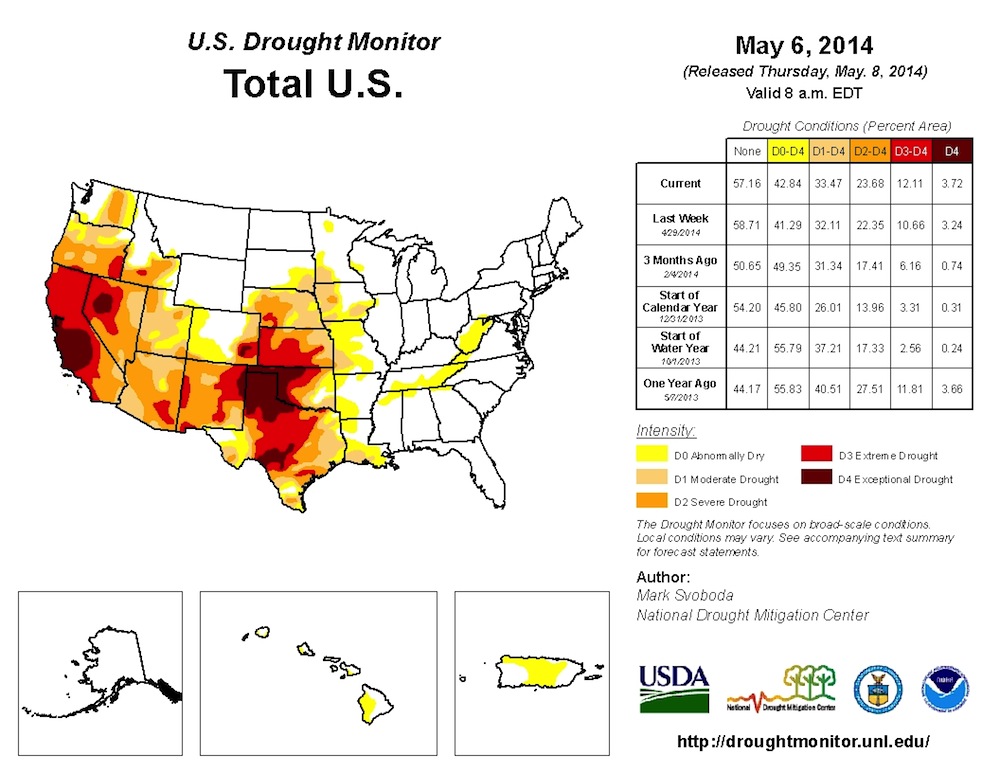Partially Parched: Half of US Is In Drought

Half of the United States is experiencing drought, according to the latest numbers from the U.S. National Drought Monitor.
The drought is deepest in California and the Texas and Oklahoma panhandles, according to the latest drought map, released May 8. Most of California is in extreme or exceptional drought, and triple-digit heat was returning to Texas and Oklahoma, according to Mark Svoboda of the National Drought Mitigation Center, who penned a report on recent drought conditions.
"This is not the recipe for recovery as the calendar pushes toward summer," Svoboda wrote of the heat in the Texas and Oklahoma panhandles. "What winter wheat wasn't damaged or killed off by recent hard freezes was left to bear the brunt of the heat and dryness this week, with little in the way of relief on the horizon." [Dried Up: Photos of Devastating Texas Drought]
Ongoing drought
The U.S. drought is concentrated in the Plains states and in the West, though Hawaii, Puerto Rico and the Appalachians stretching from West Virginia into eastern Tennessee are all experiencing abnormal dryness.
California has been in a state of drought for three years, and officials declared a state of emergency over the extreme lack of water in January. The final snow survey of the year, released May 1, revealed that the state's snowpack is at only 18 percent of average for that date. The northern Sierra Nevadas were particularly hard hit, with only 7 percent of water content in the snowpack compared with the average.
Even worse, a survey from April 1, when snowpack moisture is at its peak, found only 32 percent of the water content compared with historical averages, according to California's Department of Water Resources. As of April 25, the entire state of California was in some level of drought for the first time in the Drought Monitor's 15-year history.
Sign up for the Live Science daily newsletter now
Get the world’s most fascinating discoveries delivered straight to your inbox.
Meanwhile, the state's reservoirs are only at about half capacity, the Department of Water Resources warned, and the rainy season is largely over.
New normal?
Western droughts are part of the normal up-and-down of the landscape, but climate researchers warn that a parched West is likely to become more common as the globe warms.
High temperatures make typical droughts worse, climate scientists say, and droughts have become more intense and longer in tropical and subtropical areas of the globe in the past 40 years.
These changes threaten water supplies out West. They could also bring other nasty side effects, such as worsening wildfires. Western wildfires have become larger and more frequent in the last three decades, according to a study published online April 4 in the journal Geophysical Research Letters.
"Most of these trends show strong correlations with drought-related conditions, which, to a large degree, agree with what we expect from climate change projections," Max Moritz, a study co-author and fire specialist at the University of California-Berkeley Cooperative Extension, told Live Science at the time.
Follow Stephanie Pappas on Twitter and Google+. Follow us @livescience, Facebook & Google+. Original article on Live Science.

Stephanie Pappas is a contributing writer for Live Science, covering topics ranging from geoscience to archaeology to the human brain and behavior. She was previously a senior writer for Live Science but is now a freelancer based in Denver, Colorado, and regularly contributes to Scientific American and The Monitor, the monthly magazine of the American Psychological Association. Stephanie received a bachelor's degree in psychology from the University of South Carolina and a graduate certificate in science communication from the University of California, Santa Cruz.









